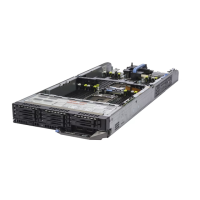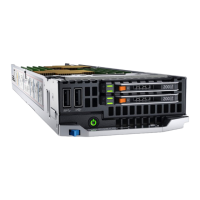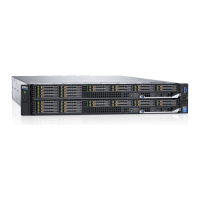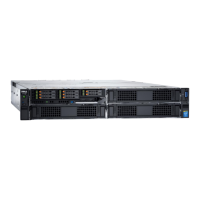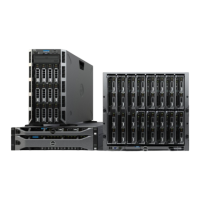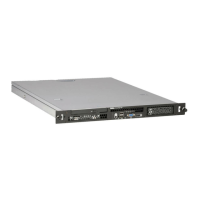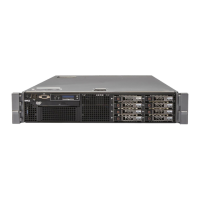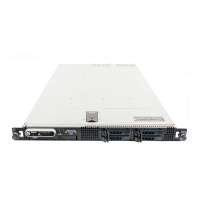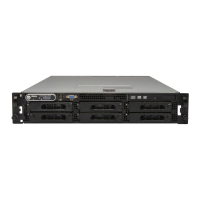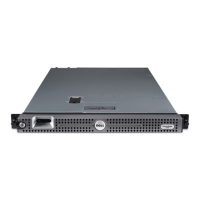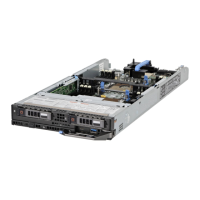
Do you have a question about the Dell PowerEdge FC640 and is the answer not in the manual?
| Management | iDRAC9 with Lifecycle Controller |
|---|---|
| Processor | Up to two Intel Xeon Scalable processors |
| Memory Slots | 16 DIMM slots |
| Storage | Up to 2 x 2.5" SAS/SATA HDD/SSD |
| RAID Support | PERC H330 |
| Chassis | Dell PowerEdge FX2/FX2s |
| Power Supply | Part of the FX2/FX2s chassis |
| Operating System Support | Microsoft Windows Server, Red Hat Enterprise Linux, SUSE Linux Enterprise Server, VMware ESXi |
| Network | 2 x 10GbE |
Displays features available on the front of the system, including ports and indicators.
Explains the system's health condition indicated by LED patterns.
Details the activity and status LED indicators for hard drives.
Describes the LED status for the iDRAC Direct port connection.
Guides on finding the system's unique Service Tag and iDRAC MAC address.
Lists tasks and corresponding documentation resources available for the system.
Provides physical dimensions of the Dell EMC PowerEdge FC640 system.
Specifies the maximum weight of the Dell EMC PowerEdge FC640 system.
Details the supported Intel Xeon Scalable Family processors for the system.
Mentions the CR 2032 3.0-V lithium coin cell system battery used by the system.
Outlines supported DDR4 RDIMMs/LRDIMMs and memory bus frequencies.
Lists supported Dell PowerEdge RAID Controllers and storage cards.
Details supported drive types, including SAS/SATA hard drives, SSDs, and PCIe NVMe drives.
Describes the various ports and connectors available on the system.
Lists the types of USB ports available on the system, including front and internal ports.
Explains the function and features of the two internal micro SD cards for hypervisors.
Mentions the dedicated micro SD card slot for future vFlash support.
Details the video controller and video memory specifications for the system.
Covers temperature and humidity specifications for system operation.
Defines limitations to prevent damage from contamination and outlines air filtration requirements.
Specifies standard operating temperature and humidity ranges for the system.
Details conditions for operating the system outside standard temperature ranges.
Lists specific restrictions and conditions for operating in expanded temperature ranges.
Provides a matrix showing thermal design power, core count, processors, and ambient restrictions.
Provides step-by-step instructions for unpacking and setting up the system.
Explains the purpose of iDRAC and its role in system management.
Details methods to configure the initial network settings for iDRAC.
Guides on how to log in to the iDRAC interface using various user types.
Lists resources for installing a supported operating system on the system.
Explains various methods for downloading system firmware and drivers.
Introduces options for managing system settings before booting the OS.
Describes how to use System Setup to configure BIOS, iDRAC, and device settings.
Provides steps to access and navigate the System Setup screen.
Explains how to configure boot order, passwords, RAID mode, and USB ports.
Explains how to view system properties like Service Tag and BIOS version.
Covers viewing and configuring memory settings, including testing and interleaving.
Guides on viewing and configuring processor settings, virtualization, and performance.
Explains how to view and configure SATA devices and RAID modes.
Covers setting NVMe drives to RAID or Non-RAID mode.
Explains how to set the boot mode (BIOS/UEFI) and boot order.
Discusses the choice between BIOS and UEFI boot modes for OS installation.
Provides instructions on how to change the system's boot order.
Covers modifying UEFI PXE, iSCSI, and HTTP boot settings.
Explains how to modify iSCSI device settings in UEFI mode.
Guides on configuring integrated devices like video, RAID controller, and USB ports.
Covers viewing and configuring serial communication ports and settings.
Explains how to configure system profiles for performance and power management.
Guides on setting system passwords, setup passwords, and disabling the power button.
Provides steps to create system and setup passwords.
Explains how to use system password for security and the behavior on incorrect attempts.
Guides on deleting or changing existing system and setup passwords.
Explains how to set up redundant OS information for recovery.
Covers updating asset tag, changing date/time, and other miscellaneous settings.
Explains the iDRAC settings utility for configuring iDRAC parameters via UEFI.
Guides on configuring device parameters.
Describes the capabilities of the Dell Lifecycle Controller for system management.
Details the role of Dell Lifecycle Controller in system lifecycle management.
Explains the Boot Manager for selecting boot options and diagnostic utilities.
Allows selection of a one-time boot device.
Lists utilities like diagnostics and UEFI shell accessible from Boot Manager.
Explains how to use the Preboot Execution Environment (PXE) for remote configuration.
Provides critical safety precautions for working inside the system.
Lists prerequisites and steps before performing internal system maintenance.
Lists prerequisites and steps after performing internal system maintenance.
Lists the necessary tools for component installation and removal procedures.
Step-by-step guide to safely remove the system from its enclosure.
Step-by-step guide to safely install the system into its enclosure.
General safety warning for working inside the system.
Explains the function of the air shroud for airflow and cooling.
Provides instructions for removing the air shroud.
Provides instructions for installing the air shroud.
Introduces the system's drive support and hot-swappable drive carriers.
Guides on how to remove a drive blank from a drive slot.
Guides on how to install a drive blank into a drive slot.
Provides instructions for removing a drive carrier.
Provides instructions for installing a drive carrier.
Guides on how to remove a hard drive from its carrier.
Guides on how to install a hard drive into its carrier.
Provides instructions for removing the drive cage assembly.
Provides instructions for installing the drive cage assembly.
Describes the drive backplane for connecting drives to the system board.
Provides instructions for removing the drive backplane.
Provides instructions for installing the drive backplane.
Explains system memory types, bus frequencies, and socket organization.
Provides recommended guidelines for best performance when installing memory modules.
Details memory population guidelines for different memory modes like sparing and mirroring.
Step-by-step guide to safely remove a memory module from its socket.
Step-by-step guide to safely install a memory module into its socket.
Explains the role of processors and heat sinks for system cooling.
Guides on safely removing the processor and heat sink module.
Provides instructions to separate the processor from its heat sink module.
Guides on how to remove the processor bracket.
Guides on installing the processor into the heat sink module, including thermal grease application.
Guides on installing the combined processor and heat sink module.
Introduces the Network Daughter Card (NDC) and its connectivity options.
Provides instructions for removing the Network Daughter Card.
Provides instructions for installing the Network Daughter Card.
Mentions support for SFF mezzanine cards and PCIe Generation 3 cards.
Provides instructions for removing a PCIe mezzanine card.
Provides instructions for installing a PCIe mezzanine card.
Describes the dedicated slot and function of the storage controller card.
Provides instructions for removing the storage controller card.
Provides instructions for installing the storage controller card.
Explains the function of the system battery.
Guides on replacing the NVRAM backup battery using Option A.
Guides on replacing the NVRAM backup battery using Option B.
Explains the use and installation of an optional internal USB memory key.
Guides on replacing an optional internal USB memory key.
Introduces the Internal Dual SD Module (IDSDM).
Provides instructions for removing the optional internal dual SD module.
Provides instructions for installing the optional internal dual SD module.
Guides on removing a micro SD card from the internal dual SD module.
Guides on installing a micro SD card into the internal dual SD module.
Defines the system board (motherboard) and its role in the computer.
Provides instructions for removing the system board.
Provides instructions for installing the system board.
Guides on entering the system Service Tag via System Setup.
Explains how to restore the Service Tag using the Easy Restore feature.
Defines the Trusted Platform Module (TPM) and its security functions.
Guides on replacing the Trusted Platform Module.
Details TPM initialization for BitLocker users.
Guides on initializing TPM 1.2 for TXT users.
Guides on initializing TPM 2.0 for TXT users.
Describes the rSPI card for storing system information.
Provides instructions for removing the rSPI card.
Provides instructions for installing the rSPI card.
Introduces Dell Embedded System Diagnostics (ePSA) for hardware testing.
Guides on running diagnostics when the system does not boot.
Guides on running diagnostics using the Dell Lifecycle Controller.
Explains the controls for system diagnostics, including configuration, results, and logs.
Identifies and describes system board jumpers and connectors.
Details the settings for specific system board jumpers like NVRAM_CLR and PWRD_EN.
Provides steps to disable system/setup passwords using the jumper.
Explains benefits of Dell SupportAssist for automated technical support.
Provides information on how to contact Dell for sales, technical assistance, or service.
Allows users to provide feedback on the documentation.
Guides on using Quick Resource Locator (QRL) for system information and videos.
